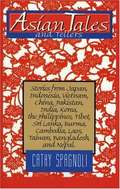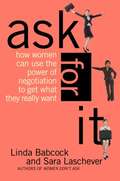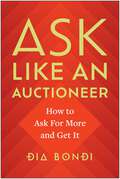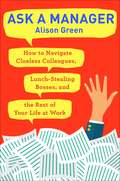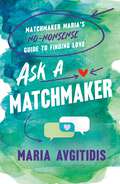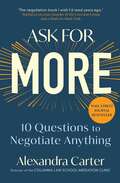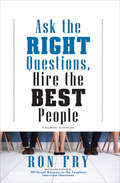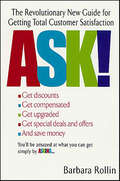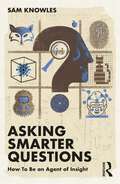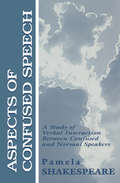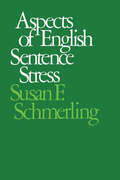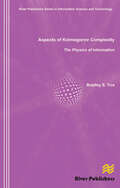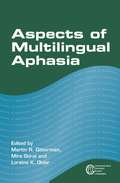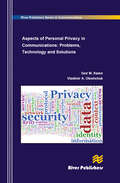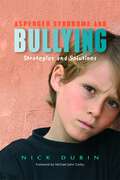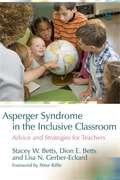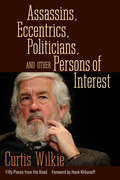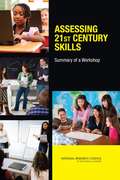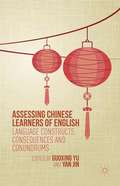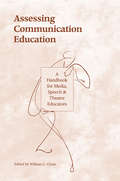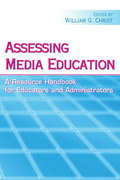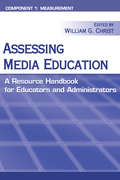- Table View
- List View
Asian Tales And Tellers
by Cathy SpagnoliIn this abundant and kaleidoscopic collection, Spagnoli includes stories from Japan, India, Korea, Vietnam, Cambodia, the Philippines, Bangladesh, Laos, Tibet, Pakistan, Sri Lanka, China, Indonesia, Taiwan, Burma, and Nepal. After profiling modern Asian storytellers practicing traditional storytelling styles, she arranges the stories around dominant Asian themes such as Harmony and Friendship
Ask For It: How Women Can Use Negotiation to Get What They Really Want
by Linda Babcock Sara LascheverTo research this groundbreaking book, Linda Babcock and Sara Laschever spent several years talking to thousands of women about the high cost of failing to ask for what they want. Through that research, one thing became abundantly clear: feelings of self doubt - that voice inside your head that says 'Don't get pushy. Do you really deserve more?' - consistently prevent women from getting the things they desire most, whether it's a pay rise, a nicer office, or even just some help around the house. In Ask for It, Babcock and Laschever have developed a unique, cooperative approach to negotiating that begins before you ever get to a bargaining table, one that will help women realise their self-worth and identify their goals as well as maximise their bargaining power. It will help propel you to new places both professionally and personally - and open doors you thought were closed. Essential reading for women everywhere, Ask For It will help you recognise how much more you deserve - and show you how to get it.
Ask Like an Auctioneer: How to Ask For More and Get It
by Dia BondiWhen we ask, we aim low—asking for what we think we can reasonably get afraid of risking too much, and get nothing at all. The result? We leave money and opportunity on the table. Communications coach Dia Bondi has helped thousands of women advocate for themselves by making big asks. In Ask Like an Auctioneer, she outlines a six-step framework that will help you strategically and confidently ask for more, maximizing the potential of every ask, every time. A communications coach for two decades, Bondi works with top CEOs, VC-backed founders, innovators, and creatives to speak powerfully and elevate their impact. After training as an auctioneer, Bondi translated the strategies she learned from the fundraising auctioneering stage into a program that helps women ask for more in their career and life. Based on Bondi&’s wildly successful keynotes and workshops, Ask Like an Auctioneer is an actionable guide that shows you the secret to getting out of your comfort zone and into your &“zone of freaking out&” (ZOFO). Among other ideas, in this book you will learn to: Set your reserve Understand price is a measure of value, not worth Find the offer in every ask Take productive action when you get a &“no&” Join the thousands of women who are stepping into their ZOFO, asking for more and getting it, and reaching their goals on their own terms.
Ask More: The Power of Questions to Open Doors, Uncover Solutions, and Spark Change
by Frank SesnoWhat hidden skill links successful people in all walks of life? The answer is surprisingly simple: they know how to ask the right questions at the right time.Questions help us break down barriers, discover secrets, solve puzzles, and imagine new ways of doing things. The right question can provide for us not only the answer we need right then but also the ones we&’ll need tomorrow.Emmy award–winning journalist and media expert Frank Sesno wants to teach you how to question others in a methodical, intentional way so that you can find the same success that others have found by mastering this simple skill.In Ask More, you will learn:How the Gates Foundation used strategic questions to plan its battle against malariaHow turnaround expert Steve Miller uses diagnostic questions to get to the heart of a company's problemsHow creative questions animated a couple of techie dreamers to brainstorm UberHow journalist Anderson Cooper uses confrontational questions to hold people accountableThroughout Ask More, you&’ll explore all different types of inquiries--from questions that cement relationships, to those that will help you plan for the future. By the end, you&’ll know what to ask and when, what you should listen for, and what you can expect as the outcome.
Ask Outrageously!: The Secret to Getting What You Really Want
by Linda Byars Swindling Linda Swindling&“Learn how to &‘ask outrageously&’ for what you want—and get what you need—with this bold guide to self-confidence.&” —Daniel H. Pink, New York Times–bestselling author of Drive and To Sell Is Human Stop Holding Yourself Back—It's Time to Go Ask! The strongest relationships, top sales groups, and most successful organizations have one thing in common: people who have the courage to ask outrageously. This doesn&’t mean being obnoxious or taking advantage of people. It means not compromising, taking a risk to get what you know you need, not what you think you can get. Based on Linda Swindling&’s original research and her experience helping people make high-stakes requests in everything from business negotiations to marriage proposals, this book offers proven approaches to improve your asking and boost your chances of success. Whether you are a professional looking for a bigger opportunity, an entrepreneur striving to build a company, a nonprofit seeking funding, or simply a parent or friend wanting a more fulfilling relationship, it's time to make that big ask! Get ready. Your results will surpass your greatest expectations! IBPA Benjamin Franklin Award silver winner in the Self-Help category. &“Linda Swindling has nailed the way to get better results: Ask Outrageously up front. People trust the clear and distrust the ambiguous. Read the book and practice the techniques—trust me on this!&” —David Horsager, bestselling author of The Trust Edge and CEO Trust Edge Leadership Institute &“If this is the only book you read this year, get it, read it, learn the content and reap new rewards.&” —Don Hutson, New York Times–bestselling co-author of The One Minute Entrepreneur
Ask a Manager: How to Navigate Clueless Colleagues, Lunch-Stealing Bosses and Other Tricky Situations at Work
by Alison Green'I'm a HUGE fan of Alison Green's "Ask a Manager" column. This book is even better' Robert Sutton, author of The No Asshole Rule and The Asshole Survival Guide'Ask A Manager is the book I wish I'd had in my desk drawer when I was starting out (or even, let's be honest, fifteen years in)' - Sarah Knight, New York Times bestselling author of The Life-Changing Magic of Not Giving a F*ck A witty, practical guide to navigating 200 difficult professional conversationsTen years as a workplace advice columnist has taught Alison Green that people avoid awkward conversations in the office because they don't know what to say. Thankfully, Alison does. In this incredibly helpful book, she takes on the tough discussions you may need to have during your career.You'll learn what to say when:· colleagues push their work on you - then take credit for it· you accidentally trash-talk someone in an email and hit 'reply all'· you're being micromanaged - or not being managed at all· your boss seems unhappy with your work· you got too drunk at the Christmas partyWith sharp, sage advice and candid letters from real-life readers, Ask a Manager will help you successfully navigate the stormy seas of office life.
Ask a Manager: How to Navigate Clueless Colleagues, Lunch-Stealing Bosses, and the Rest of Your Life at Work
by Alison GreenThe ideal graduation gift for anyone about to enter the workforce, a witty, practical guide to 200 difficult professional conversations—featuring all-new advice from the creator of the popular website Ask a Manager and New York’s work-advice columnist. There’s a reason Alison Green has been called “the Dear Abby of the work world.” Ten years as a workplace-advice columnist have taught her that people avoid awkward conversations in the office because they simply don’t know what to say. Thankfully, Green does—and in this incredibly helpful book, she tackles the tough discussions you may need to have during your career. You’ll learn what to say when • coworkers push their work on you—then take credit for it • you accidentally trash-talk someone in an email then hit “reply all” • you’re being micromanaged—or not being managed at all • you catch a colleague in a lie • your boss seems unhappy with your work • your cubemate’s loud speakerphone is making you homicidal • you got drunk at the holiday partyAdvance praise for Ask a Manager“A must-read for anyone who works . . . [Alison Green’s] advice boils down to the idea that you should be professional (even when others are not) and that communicating in a straightforward manner with candor and kindness will get you far, no matter where you work.”—Booklist (starred review) “The author’s friendly, warm, no-nonsense writing is a pleasure to read, and her advice can be widely applied to relationships in all areas of readers’ lives. Ideal for anyone new to the job market or new to management, or anyone hoping to improve their work experience.”—Library Journal (starred review) “I am a huge fan of Alison Green’s Ask a Manager column. This book is even better. It teaches us how to deal with many of the most vexing big and little problems in our workplaces—and to do so with grace, confidence, and a sense of humor.”—Robert Sutton, Stanford professor and author of The No Asshole Rule and The Asshole Survival Guide “Ask a Manager is the ultimate playbook for navigating the traditional workforce in a diplomatic but firm way.”—Erin Lowry, author of Broke Millennial: Stop Scraping By and Get Your Financial Life Together
Ask a Matchmaker: Matchmaker Maria's No-Nonsense Guide to Finding Love
by Author Maria AvgitidisINSTANT NATIONAL BESTSELLERFrom renowned, fourth-generation matchmaker, Maria Avgitidis, comes a fresh, modern dating book that meets anyone navigating the world of dating and relationships where they're at, helping them to attract and grow the partnership of their dreams.In today's world, dating can feel like a never-ending cycle of swipes and small talk, where real connections are hard to come by. But the dream of meeting “The One” isn’t out of reach. Blending personal stories and professional insights, Maria Avgitidis, or Matchmaker Maria, offers the kind of straight-talking, no-nonsense advice that only a true friend can give, guiding you to understand your dating options in a whole new way. By covering everything from personality typing systems to compatibility to Maria’s own developed rules and theories, Ask a Matchmaker equips you to diagnose your own relationship dilemmas and address them with confidence.
Ask for More: 10 Questions to Negotiate Anything
by Alexandra CarterAn instant Wall Street Journal bestseller and &“a joy to read&” (Douglas Stone and Sheila Heen, authors of Difficult Conversations), Ask for More shows that by asking better questions, you get better answers—and better results from any negotiation.Negotiation is not a zero-sum game. It&’s an essential skill for your career that can also improve your closest relationships and your everyday life. Still, people often shy away from it, feeling defeated before they&’ve even started. In this groundbreaking new book on negotiation, Alexandra Carter—Columbia law professor and mediation expert who has helped students, business professionals, the United Nations, and more—offers a straightforward accessible approach anyone can use to ask for and receive more. We&’ve been taught incorrectly that the loudest and most assertive voice prevails in any negotiation, or otherwise, both sides compromise, ending up with less. Instead, Carter shows that you get far more value by asking the right questions of the person you&’re negotiating with than you do from arguing with them. She offers a simple yet powerful ten-question framework for successful negotiation where both sides emerge victorious. Carter&’s proven method extends far beyond one &“yes&” and instead creates value that lasts a lifetime. Ask for More is &“like having a negotiation coach in your corner&” (Linda Babcock, author of Women Don&’t Ask) and gives you the tools to bring clarity and perspective to any critical discussion, no matter the topic.
Ask the Right Questions, Hire the Best People
by Ron FryA practical guide for employers who want to find—and hire—the best candidate for the position. In this completely updated new edition, the bestselling author of 101 Great Answers to the Toughest Interview Questions and 101 Smart Questions to Ask on Your Interview takes you step-by-step through the hiring process. Whether you’re replacing an employee who’s leaving or creating a new position in your organization, Ron Fry shows you how to write a concise and accurate job description, identify key competencies, and how to translate them into a realistic set of search criteria. Ask the Right Questions, Hire the Best People also shows you: How to attract the best applicantsWhat to look for when you’re screening résumés, in your office or onlineWhat questions you should ask in the interview . . . and when to ask themHow to listen more effectively to what the applicant is really telling youHow to probe for information the applicant doesn’t want to revealWhat questions the law permits and forbids Whether you’re an interviewing novice or a seasoned pro, you’ll find all the answers you need in Ask the Right Questions, Hire the Best People, including new chapters on questions for managers and executives, identifying core competencies, and unearthing hidden objections.
Ask!: The Revolutionary New Guide for Getting Total Customer Satisfaction
by Barbara RollinIt's the simplest technique imaginable, and it can save you hours of your time, hundreds of headaches, and thousands of dollars.Barbara Rollin has saved a small fortune by using a technique that is so simple, so easy, that anyone can do it. By using the power of "Asking," Barbara Rollin has gotten refunds, discounts, deals, lower prices, and customer satisfaction beyond her wildest dreams. In Ask! you will learn her strategies to:-Get credit card companies to lower your interest rates-Make stores pay for your time when deliveries are late-Get hotels to lower their room rates upon check-in-Receive refunds for disappointing merchandise-even years later-Learn to ask for and get better medical care-Stop accepting anything less than a totally satisfying restaurant meal-Return anything to a store-even if they have a "no returns" policy-And much more!Barbara Rollin has learned in her years of steadily more audacious "Asking" that companies will comply-usually with a smile. Everyone has the power to "Ask" for satisfaction, without whining or complaining. The stories and anecdotes in Ask! will demonstrate that power to you, so that you can begin getting more than you ever dreamed possible through these simple techniques.
Asking Smarter Questions: How To Be an Agent of Insight (Using Data Better)
by Sam KnowlesInsight is the superpower that drives innovation and enables us to understand the world from other peoples’ points of view, be they customers or colleagues, advocates or competitors. This new book from data storyteller Sam Knowles explains how to ask smarter questions – questions that, by design, stimulate more useful answers. This is the shortcut to better productivity, fast-tracked innovation, and organisational success – for businesses, universities, charities, and governments. For too long, the simple act of asking questions has been overlooked as almost too trivial to contemplate. Asking Smarter Questions seeks to champion the art of curiosity by setting out a framework to make every question count. The fundamental building blocks of insight are data and information, joined together in new and often unpredictable ways. The way we surface new data and information and make meaningful connections between data points is by asking smarter questions. By taking this approach, you can make your organisation a less confrontational, more collaborative, and more productive environment in which to work – particularly in the more distributed and remote settings that will characterise the 2020s. Managers, directors, and leaders will find the universal principles, expert interviews, and data-driven recommendations a source of inspiration to share with their teams. Asking Smarter Questions is aimed at professionals in businesses and organisations across all sectors, and will help those working in many functions, including market research, intelligence, insight, analytics, strategy, marketing, communications, planning, product development, and innovation.
Aspects of Confused Speech: A Study of Verbal Interaction Between Confused and Normal Speakers (Routledge Communication Series)
by Pamela ShakespeareBased on research focusing on the experience of having confused speech and being with confused speakers, this book begins with everyday, commonly understood ideas such as "talking too much" and examines how confused speech is "brought off" as a collaborative activity by the people involved. The author became involved in this project because she was interested in how "confusion" seemed to be something that everyone is not only involved in but also recognizes as part of ordinary life. At the same time, "confusion" is a word that is used somewhat as a blanket category for some people considered permanently incompetent and "set apart" from ordinary members of society. Her study analyzes how talk between confused and normal speakers throws light on this tension.
Aspects of English Sentence Stress
by Susan F. SchmerlingAspects of English Sentence Stress is written within the conceptual framework of generative-transformational grammar. However, it is atheoretical in the sense that the proposals made cannot be formulated in this theory and are a challenge to many other theories. The author's concern is not with the phonetic nature of stress; rather, using a working definition of stress as subjective impression of prominence, she attempts to formulate general principles that will predict the relative prominence of different words in particular utterances-what might be called the syntax of stress. She supports her arguments with a large amount of original data and provides the basis for new ways of thinking about this area of linguistic research. Schmerling begins with a detailed review and critique of Noam Chomsky and Morris Halle's approach to sentence stress; she shows that their cyclic analysis cannot be considered valid, even for quite simple phrases and sentences. Next, she reviews discussions of sentence stress by Joan Bresnan, George Lakoff, and Dwight Bolinger, agreeing with Bolinger's contention that there is no intimate connection between sentence stress and syntactic structure but showing that his counterproposal to the standard approach is inadequate as well. She also examines the concept of "normal stress" and demonstrates that no linguistically significant distinction can be drawn between "normal" and "special" stress contours. In generating her own proposals concerning sentence stress, Professor Schmerling takes the view that certain items which are stressable are taken for granted by the speaker and are eliminated from consideration by the principles governing relative prominence of words in a sentence. Then she examines the pragmatic and phonological principles pertaining to items that are not eliminated from consideration. Finally, the author contends that the standard views, which she shows to be untenable, are a result of the assumption that linguistic entities should be studied apart from questions concerning their use, in that it was adoption of this methodological assumption that forced linguists to deny the essentially pragmatic nature of sentence stress. Accessible to anyone who is familiar with the basic concepts of generative-transformational grammar, Aspects of English Sentence Stress presents provocative ideas in the field.
Aspects of Kolmogorov Complexity the Physics of Information (River Publishers Series In Information Science And Technology Ser.)
by Bradley S. TiceThe research presented in Aspects of Kolmogorov Complexity addresses the fundamental standard of defining randomness as measured by a Martin-Lof level of randomness as found in random sequential binary strings. A classical study of statistics that addresses both a fundamental standard of statistics as well as an applied measure for statistical communication theory. The research points to compression levels in a random state that are greater than is found in current literature. A historical overview of the field of Kolmogorov Complexity and Algorithmic Information Theory, a subfield of Information Theory, is given as well as examples using a radix 3, radix 4, and radix 5 base numbers for both random and non-random sequential strings. The text also examines monochromatic and chromatic symbols and both theoretical and applied aspects of data compression as they relate to the transmission and storage of information. The appendix contains papers on the subject given at conferences and the references are current.ContentsTechnical topics addressed in Aspects of Kolmogorov Complexity include:• Statistical Communication Theory• Algorithmic Information Theory• Kolmogorov Complexity• Martin-Lof Randomness• Compression, Transmission and Storage of Information
Aspects of Multilingual Aphasia
by Martin R. Gitterman Mira GoralThis volume provides a broad overview of current work in aphasia in individuals who speak more than one language. With contributions from many of the leading researchers in the field, the material included, both experimental work and theoretical overviews, should prove useful to both researchers and clinicians. The book should also appeal to a broader audience, including all who have an interest in the study of language disorders in an increasingly multicultural/multilingual world (e.g. students of speech-language pathology and linguistics). The areas of multilingual aphasia addressed in this collection include assessment and treatment, language phenomena (e.g. code-switching), particular language pairs (including a bidialectal study), and the role of cultural context.
Aspects of Personal Privacy in Communications - Problems, Technology and Solutions
by Geir M. Koien Vladimir a. OleshchukThe modern society is rapidly becoming a fully digital society. This has many benefits, but unfortunately it also means that personal privacy is threatened. The threat does not so much come from a 1984 style Big Brother, but rather from a set of smaller big brothers. The small big brothers are companies that we interact with; they are public services and institutions. Many of these little big brothers are indeed also being invited to our private data by ourselves. Privacy as a subject can be problematic. At the extreme it is personal freedom against safety and security. We shall not take a political stand on personal privacy and what level of personal freedom and privacy is the correct one.Aspects of Personal Privacy in Communications is mostly about understanding what privacy is and some of the technologies may help us to regain a bit of privacy. We discuss what privacy is about, what the different aspects of privacy may be and why privacy needs to be there by default.There are boundaries between personal privacy and societal requirements, and inevitably society will set limits to our privacy (Lawful Interception, etc.).There are technologies that are specifically designed to help us regain some digital privacy. These are commonly known as Privacy Enhancing Technologies (PETs). We investigate some these PETs including MIX networks, Onion Routing and various privacy-preserving methods. Other aspects include identity and location privacy in cellular systems, privacy in RFID, Internet-of-Things (IoT) and sensor networks amongst others. Some aspects of cloud systems are also covered.
Asperger Syndrome and Bullying: Strategies and Solutions
by Nick DubinBullying is a serious problem for people with Asperger Syndrome (AS), both at school and in the workplace, and displaying 'different' behavior, such as not understanding social rules or hand-flapping, exacerbates the risk of being victimized. Writing in an accessible, informal style, the author describes the bullying behavior he and other individuals have experienced, and the effect this has had on their lives. He outlines the reasons for bullying behavior and the danger of persistent recurrence if it remains unchecked, as well as the critical importance of 'involving the bystander'. Nick Dubin goes on to provide a range of effective strategies to address bullies and bullying that can be applied by parents, professionals, schools, and individuals being bullied. He stresses the importance of peer intervention, empathetic teachers, and verbal self-defense, and shows how lack of support, condemning of 'tale telling,' or even blaming the victim reinforces bullying. This book offers individuals with AS who are being bullied the opportunity to see that they are not alone, and it is an invaluable source of advice for parents, teachers, professionals and personnel managers.
Asperger Syndrome in the Inclusive Classroom: Advice and Strategies for Teachers
by Dion Betts Stacey W. Betts Lisa N. Gerber-EckardAsperger Syndrome in the Inclusive Classroom offers support and practical techniques for teachers who work with children with Asperger Syndrome (AS). Based on the successful experiences of classroom teachers, and written from a teacher's perspective, this book provides creative and easy-to-apply strategies that support and encourage AS students in the mainstream classroom, from organization and time management techniques to framing classroom instructions to make lessons more accessible for children with AS. The authors' straightforward, practical advice relates to every part of the school day and includes advice for teaching specific subject areas. They give tips on helping students navigate the school environment, how to handle social situations like lunch and breaks, and what to do during unstructured periods. This book is essential reading for teachers and school staff who want to fully include AS students in the classroom.
Assassins, Eccentrics, Politicians, and Other Persons of Interest: Fifty Pieces from the Road
by Curtis WilkieWriting as a newspaper reporter for nearly forty years, Curtis Wilkie covered eight presidential campaigns, spent years in the Middle East, and traveled to a number of conflicts abroad. However, his memory keeps turning home and many of his most treasured stories transpire in the Deep South. He called his native Mississippi, “the gift that keeps on giving.” For Wilkie, it represented a trove of rogues and racists, colorful personalities and outlandish politicians who managed to thrive among people otherwise kind and generous. Assassins, Eccentrics, Politicians, and Other Persons of Interest collects news dispatches and feature stories from the author during a journalism career that began in 1963 and lasted until 2000. As a young reporter for the Clarksdale Press Register, he wrote many articles that dealt with the civil rights movement, which dominated the news in the Mississippi Delta during the 1960s.Wilkie spent twenty-six years as a national and foreign correspondent for the Boston Globe. One of the original “Boys on the Bus” (the title of a best-selling book about journalists covering the 1972 presidential campaign), he later wrote extensively about the winning races of two southern Presidents, Jimmy Carter and Bill Clinton. Wilkie is known for stories reported deeply, rife with anecdotes, physical descriptions, and important background details. He writes about the notorious, such as the late Hunter S. Thompson, as well as more anonymous subjects whose stories, in his hands, have enduring interest. The anthology collects pieces about several notable southerners: Ross Barnett; Byron De La Beckwith and Sam Bowers; Billy Carter; Edwin Edwards and David Duke; Trent Lott; and Charles Evers. Wilkie brings a perceptive eye to people and events, and his eloquent storytelling represents some of the best journalistic writing.
Assessing 21st Century Skills: Summary of a Workshop
by Judith Anderson KoenigThe routine jobs of yesterday are being replaced by technology and/or shipped off-shore. In their place, job categories that require knowledge management, abstract reasoning, and personal services seem to be growing. The modern workplace requires workers to have broad cognitive and affective skills. Often referred to as "21st century skills," these skills include being able to solve complex problems, to think critically about tasks, to effectively communicate with people from a variety of different cultures and using a variety of different techniques, to work in collaboration with others, to adapt to rapidly changing environments and conditions for performing tasks, to effectively manage one's work, and to acquire new skills and information on one's own. The National Research Council (NRC) has convened two prior workshops on the topic of 21st century skills. The first, held in 2007, was designed to examine research on the skills required for the 21st century workplace and the extent to which they are meaningfully different from earlier eras and require corresponding changes in educational experiences. The second workshop, held in 2009, was designed to explore demand for these types of skills, consider intersections between science education reform goals and 21st century skills, examine models of high-quality science instruction that may develop the skills, and consider science teacher readiness for 21st century skills. The third workshop was intended to delve more deeply into the topic of assessment. The goal for this workshop was to capitalize on the prior efforts and explore strategies for assessing the five skills identified earlier. The Committee on the Assessment of 21st Century Skills was asked to organize a workshop that reviewed the assessments and related research for each of the five skills identified at the previous workshops, with special attention to recent developments in technology-enabled assessment of critical thinking and problem-solving skills. In designing the workshop, the committee collapsed the five skills into three broad clusters as shown below: Cognitive skills: nonroutine problem solving, critical thinking, systems thinking Interpersonal skills: complex communication, social skills, team-work, cultural sensitivity, dealing with diversity Intrapersonal skills: self-management, time management, self-development, self-regulation, adaptability, executive functioning Assessing 21st Century Skills provides an integrated summary of the presentations and discussions from both parts of the third workshop.
Assessing Chinese Learners of English: Language Constructs, Consequences And Conundrums
by Guoxing YuThis volume gathers researchers from around the world endeavouring to better understand a number of perennial issues in assessing Chinese learners of English, covering topics such as students' test performances, interactional competence and lexical knowledge, students' motivation, teachers' attitudes and assessment policy changes.
Assessing Communication Education: A Handbook for Media, Speech, and Theatre Educators (Routledge Communication Series)
by William G. ChristDesigned as a handbook, this text provides media, speech (public speaking, interpersonal, small group, and organizational communication), and theatre educators with both the theoretical and practical ammunition to fight the assessment battles on their campuses. The philosophical implications of accountability are balanced with concrete, specific, and usable assessment strategies. Stressing student, faculty, course, program, department, and institutional assessment, this book's aim is to provide, in one place, information that will help diverse and complex communication programs face the growing challenges in assessment. The book is divided into three sections: background and foundational information for assessment; broad assessment strategies that apply to a variety of media, "speech," and theatre courses and programs; and context-specific assessment strategies. While covering a host of topics, it: * provides an overview of assessment and suggests how it might impact communication education, * discusses the elements of program assessment and how linkage of mission statements with outcomes can lead to strong, innovative programs, * compares and contrasts regional association requirements and presents a specific how-to strategy for writing outcome statements, * discusses teaching evaluation and argues that we need to identify the "what" of teaching before we try to measure the "how," * looks at creative ways for formative and summative course evaluation that starts with the creation of an explicit syllabus, * discusses the use of capstone courses as a way of evaluating not only their major but also how students have integrated their "total" educational experience, * suggests the variety of ways that interpersonal communication can be assessed and calls for future research that stresses the "knowledge" component of learning, * reports on a strategy for developing small group communication assessment measures, and * provides media, speech, and theatre faculty and administrators with the background, understanding and tools to build stonger programs and develop better courses and educational experiences for their students.
Assessing Media Education: A Resource Handbook for Educators and Administrators (Routledge Communication Series)
by William G. ChristThis component of Assessing Media Education is intended for those who would like to know how other schools have grappled with implementing assessment initiatives, and who have used assessment to improve their programs.
Assessing Media Education: A Resource Handbook for Educators and Administrators: Component 1: Measurement (Routledge Communication Ser.)
by William G. ChristThe chapters included in this component of Assessing Media Education are intended for those who have already developed an assessment plan and identified key student learning outcomes, and who need more information on how to measure the outcomes both indirectly and directly.
